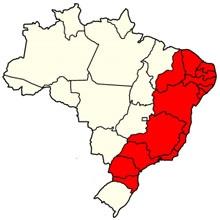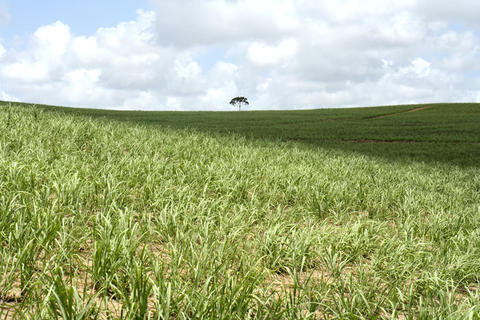This article was contributed by Nathan P. Smith and Scott A. Mori
In Brazil, the coastal region that stretches from the northeastern state of Piauí to the southern state of Santa Catarina (red area of map) is home to 21 native species of the Brazil nut family (Lecythidaceae). The majority of these species occur in the Atlantic Forest, one of the most diverse and threatened ecosystems in the world, and others have adapted to live in dryer habitats.
Diversity
Within the Lecythidaceae, the species from this region represent only 6% of the worldwide diversity (ca. 300 speices) and 16% of the diversity in the country (118 species). Of the 10 genera that occur in the Western Hemisphere, five (Cariniana, Couratari, Eschweilera, Gustavia, and Lecythis) are native to eastern Brazil and two non-native genera (Bertholletia and Couroupita) are cultivated as ornamentals. These species range from very small trees (e.g., Eschweilera nana) to some of the tallest trees in South America (e.g., Cariniana estrellensis) that can reach 60 m (200 ft)!
The Brazil nut family has some of the most spectacular and morphologically complex flowers in the world. In eastern Brazil, flowers of species in this family range from less than 0.5 cm (e.g., Cariniana legalis) to over 15 cm diam. (e.g., Gustavia augusta), can be radially symmetric to highly asymmetric, and many have a unique structure called a hood that arches over the fertile stamens (see photo gallery for examples) and provides sterile pollen and nectar to pollinators (e.g., bees). In addition, many species have large dehiscent fruits and seeds with arils (a fleshy structure attached to the base or side of the seed) that are an important food source for bats, monkeys, and other animals. Other species have dehiscent fruits that produce winged, wind-dispersed seeds, such as those of Cariniana and Couratari, and the fruits of Gustavia augusta are indehiscent and have seeds that are embedded in a pulp that is eaten by mammals (e.g., species of monkeys).
Cultivated Species
At least four species of Lecythidaceae are cultivated as ornamental trees in this region. Couroupita guianensis, also known as the cannnonball tree (English), castanha de macaco (Portuguese) and bolo de cañon (Spanish), is by far the most common ornamental Lecythidaceae. This species is native to Amazonia but is cultivated in botanical gardens worldwide because of its large, unusual flowers and cannonball-like fruits that hang from its trunk. In eastern Brazil, this species is often found in city parks and sometimes as a street tree. Bertholletia excelsa (the Brazil nut), which is also native to Amazonia, and Lecythis pisonis are occasionally cultivated as ornamentals in warmer regions of eastern Brazil. In the states of São Paulo and Rio de Janeiro, Lecythis lanceolata, Cariniana estrellensis, and C. legalis are also cultivated as ornamentals.
Conservation
 For many years, the forests of eastern Brazil have been threatened by the expansion of agricultural operations and human settlements. As a result, less than 10% of the primary Atlantic Forest of eastern Brazil remains and many of the species native to this region are now rare. In fact, over 50% of the Lecythidaceae species native to eastern Brazil are on the IUCN Red List of Threatened Species and 25% of the species are considered endangered
For many years, the forests of eastern Brazil have been threatened by the expansion of agricultural operations and human settlements. As a result, less than 10% of the primary Atlantic Forest of eastern Brazil remains and many of the species native to this region are now rare. In fact, over 50% of the Lecythidaceae species native to eastern Brazil are on the IUCN Red List of Threatened Species and 25% of the species are considered endangered
A significant amount of this deforestation occurred when large sugarcane farms were established (e.g., see image from the state of Paraíba). Sugar from these farms is now used to produce alcohol that is exported and sold throughout the country as an alternative fuel for cars (unlike the United States, most of the cars sold in Brazil now come with engines that can burn gas or alcohol). As a result, the Atlantic Forest in northeastern Brazil has been reduced to occasional reserves and fragments of secondary forest. For more information about the distribution and conservation status of these species consult our checklist of species from eastern Brazil.
Add new comment